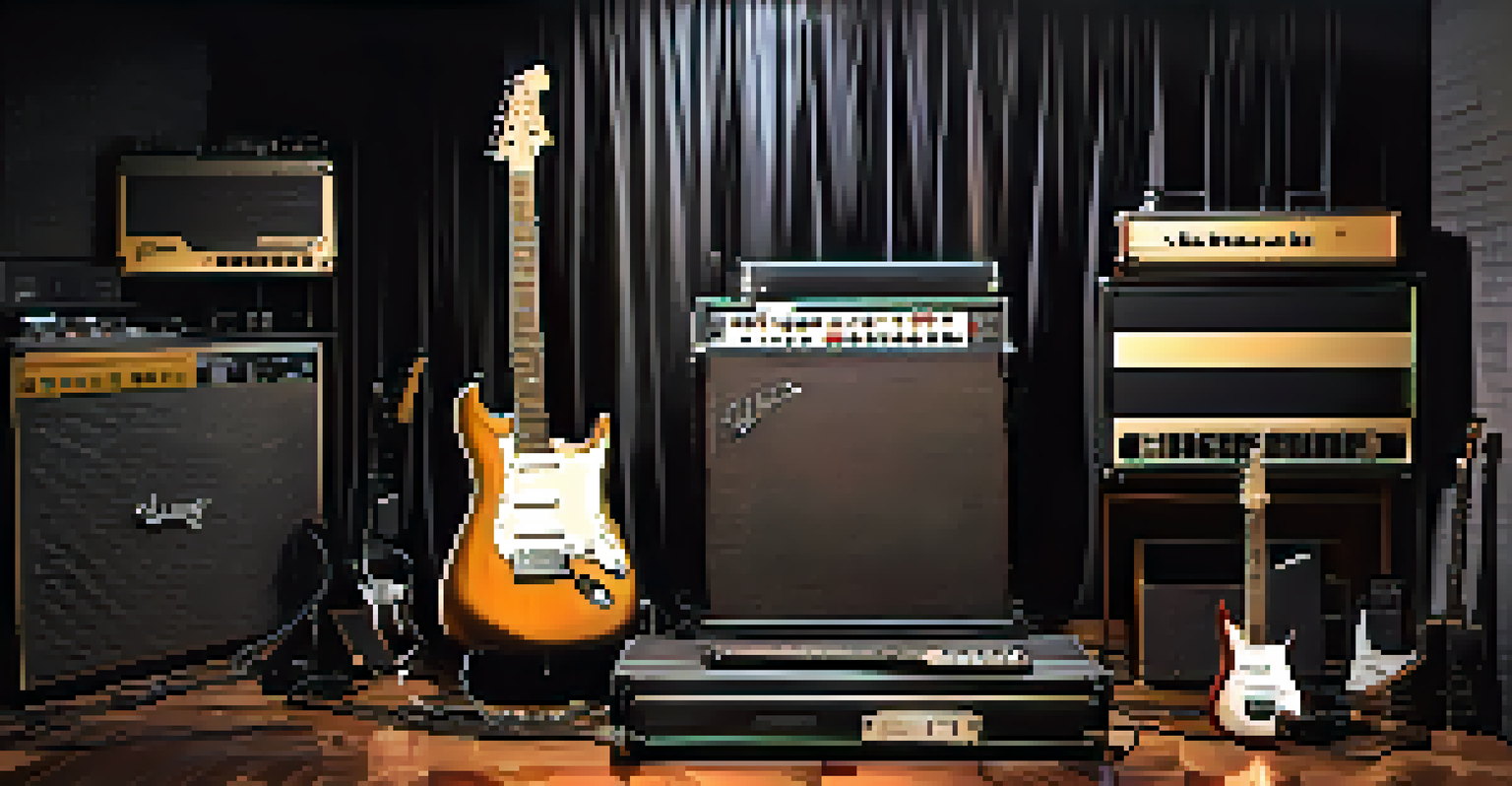Heavy Metal Evolution: Guitar's Role in the Genre

The Birth of Heavy Metal: A Musical Revolution
Heavy metal emerged in the late 1960s, with bands like Black Sabbath and Led Zeppelin pioneering the sound. Their heavy guitar riffs and powerful vocals set the stage for a genre that would soon evolve dramatically. This period marked a shift from traditional rock music to something darker and more intense, captivating a generation of listeners.
Heavy metal is the ultimate in musical rebellion, a bold expression of individuality and defiance.
The guitar became the backbone of this new sound, providing both rhythm and melody. With distorted tones and aggressive playing styles, guitarists began to explore a range of techniques, from power chords to intricate solos. This creativity would lay the groundwork for future developments in heavy metal guitar playing.
As the genre grew, so did the guitar's role in defining its identity. It was no longer just an instrument; it became a symbol of rebellion and power. The heavy metal guitar was here to stay, and its influence would only expand as the genre evolved.
The Rise of Iconic Guitarists in the 70s and 80s
The 1970s and 80s brought a wave of legendary guitarists who would shape the heavy metal landscape. Icons like Eddie Van Halen, Randy Rhoads, and Tony Iommi pushed the boundaries of guitar playing, introducing techniques like tapping and sweeping arpeggios. Their innovative styles not only influenced their contemporaries but also inspired countless future musicians.

This era was characterized by the emergence of subgenres, such as thrash and speed metal, which demanded even more technical proficiency from guitarists. Bands like Metallica and Slayer showcased rapid tempos and complex riffs, elevating the guitar's role to new heights. The guitar solos became a defining feature of heavy metal songs, creating moments of exhilaration and excitement.
Heavy Metal's Guitar Evolution
From the heavy riffs of Black Sabbath to modern techniques, the guitar has continually evolved in heavy metal, shaping its identity.
Moreover, the guitar's prominence in heavy metal culture extended beyond the music itself. It became a powerful tool for self-expression, often reflecting the angst and rebellion of youth. Fans began to identify with their favorite guitarists, seeing them as heroes who embodied the spirit of heavy metal.
The Technological Advancements in Guitar Gear
As heavy metal evolved, so did the technology that guitarists relied on. The introduction of effects pedals, amplifiers, and advanced guitar designs allowed musicians to experiment with their sound like never before. This technological revolution paved the way for heavier tones and more complex arrangements, enhancing the overall experience of heavy metal music.
The guitar is a powerful instrument; it can express emotions that words cannot.
Guitarists began incorporating a wider range of sounds into their playing, utilizing distortion, delay, and modulation effects to create atmospheric textures. This experimentation opened new doors for creativity, leading to the development of subgenres like progressive metal and metalcore. Each advancement in gear allowed artists to push the envelope further, challenging the status quo.
For many guitarists, finding the right gear became an essential part of their identity. Signature models and custom setups became commonplace, as musicians sought to create their unique sound. The guitar was not just an instrument; it was an extension of their artistic vision and a crucial component of their musical expression.
The Cultural Impact of Heavy Metal Guitarists
Heavy metal guitarists have often been seen as cultural icons, with their influence reaching far beyond the music scene. They’ve inspired fashion trends, art, and even attitudes towards individuality and rebellion. The image of the guitarist, with long hair and a guitar slung low, became synonymous with the heavy metal lifestyle.
Many guitarists have also become vocal advocates for various social and political causes, using their platforms to raise awareness. This merging of music and activism further solidified the guitar's role as a powerful instrument of change. It showed that heavy metal was not just about the riffs but also about the messages conveyed through the music.
Cultural Icons of Heavy Metal
Heavy metal guitarists have transcended music, influencing fashion, art, and social activism, becoming symbols of rebellion and individuality.
The cultural significance of these guitarists continues to resonate today, as new generations of musicians look up to them. Their legacies live on in the music of contemporary bands, reminding us of the profound impact a single instrument can have on an entire genre and its community.
Evolution of Guitar Techniques in Heavy Metal
Throughout the years, heavy metal guitar techniques have evolved significantly, with each generation of musicians bringing something new to the table. From the classic blues-influenced solos of the 70s to the intricate finger-tapping of the 80s, guitarists have continuously pushed the boundaries of what is possible. This evolution reflects the genre’s desire for innovation and technical prowess.
Modern heavy metal incorporates a diverse range of styles, including jazz, classical, and even electronic elements. Guitarists now experiment with unconventional scales and rhythms, creating a rich tapestry of sound. This blending of influences has led to a more inclusive approach to heavy metal guitar playing, opening the door for new ideas and collaborations.
The rise of digital technology has also transformed guitar techniques, with online tutorials and platforms allowing musicians to learn and share their skills. This accessibility has fostered a global community of guitarists who inspire one another and elevate the genre as a whole. The evolution of guitar techniques in heavy metal is a testament to the genre's dynamic nature and its ability to adapt over time.
The Role of Guitar in Heavy Metal Lyrics and Themes
While heavy metal is often associated with its powerful guitar riffs, the instrument also plays a crucial role in conveying the genre's themes and lyrics. The emotive nature of guitar playing can enhance the storytelling aspect of heavy metal music, allowing listeners to connect on a deeper level. Riffs and solos often reflect the angst, rebellion, and fantasy that characterize the genre.
Many heavy metal songs utilize guitar melodies to complement their lyrical themes, creating a symbiotic relationship between the two. For instance, a soaring solo can amplify feelings of triumph or despair, making the message more impactful. This interplay between guitar and lyrics is what makes heavy metal such a compelling musical experience.
Future of Guitar in Heavy Metal
Emerging technologies and new subgenres are set to further evolve the role of guitar in heavy metal, ensuring its vibrant future.
As the genre has evolved, so too have the themes explored in heavy metal music, from personal struggles to social commentary. Guitarists have adapted their playing styles to match these shifting narratives, ensuring that the music remains relevant and resonant. The guitar is not just an instrument; it’s a powerful storyteller that helps convey the emotions behind heavy metal lyrics.
The Future of Guitar in Heavy Metal Music
As we look toward the future, the role of the guitar in heavy metal is likely to continue evolving. With emerging technologies like artificial intelligence and virtual reality, musicians are finding new ways to create and perform music. This innovation opens exciting possibilities for guitarists, allowing them to push the boundaries of creativity even further.
The rise of genres like djent and progressive metal is also shaping the future of heavy metal guitar playing. These styles often incorporate complex time signatures and polyrhythms, challenging guitarists to adapt their techniques. As new subgenres emerge, the guitar will remain at the forefront, continually evolving to meet the demands of the music.

Moreover, the heavy metal community will continue to thrive, fostering new generations of guitarists who will carry the torch. As long as there are passionate musicians willing to experiment and express themselves, the guitar will remain an integral part of heavy metal. The future looks bright for heavy metal guitarists, promising exciting developments that will keep the genre alive and vibrant for years to come.